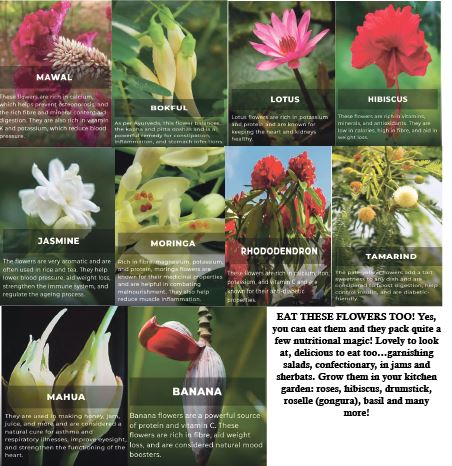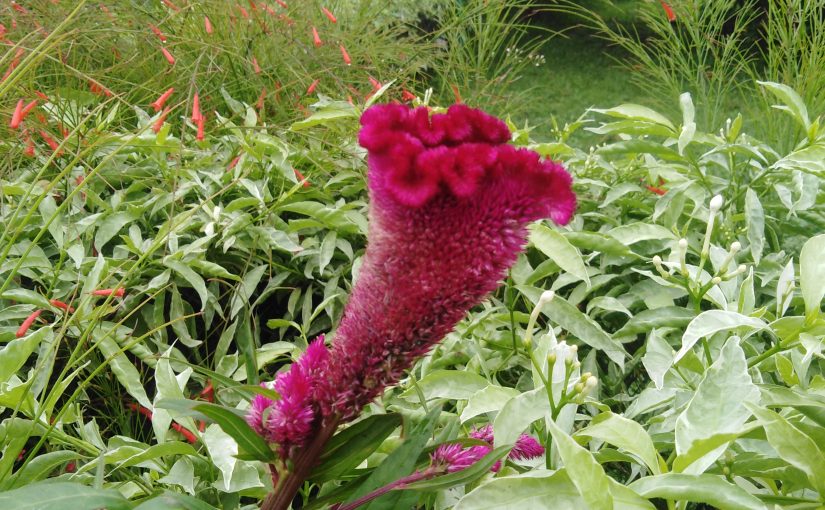THIS glorious cockscomb plant just fell in my way so that I rescued it! Also called amaranth, velvet flower, wool flower and in Kashmir it’s the mawal flower, an exciting spice or “brain food” in piece de resistance Wazwan cuisine. The Kashmiri cockscomb flower is bright red in color and Kashmiris families use the dry powder of the flowers to enrich their culinary specials…the flower is said to be good for eyes, digestion, cures eczema, reduces risk of diabetes.
By Tara Narayan
WHEN did you last think of a flower as food? Recently I did when I was visiting an old favourite place, the International Centre Goa which was hosting a meet for cancer survivors. While walking up to the reception area past the garden grounds I suddenly found myself crushing beneath my feet a thick reddish-stalked plant fallen down, the flower heads were these amazing velvety dark purplish red combs and it suddently clicked, where did I last see them? In Kashmir valley where these flowers are relished as “maval” – the flower to flavour and bring alive with color some of the Kashmiri cooking of the festive Wazwan meal for special occasions like marriages – who doesn’t recognise and love the dishes of “rogon ghosh” or “gushtaba”?
Anyway, I quickly uprighted the plant before it got crushed by a car’s wheels and finding no gardener around to appeal to grow this plant somewhere to get a mini-garden of maval phool – I just brought it home to plant in the pot near my rental home, must give it to someone who has a garden and will care for it for posterity! Maval or mawal is such a pretty flower and likely takes its name from the majestic rooster’s comb, it comes in several colors actually including Celosia argentea or silver cock’s comb…
But the purple red maval is a Kashmiri cook’s exotic spice powder, the dried red cockscomb flower powder sells for something like Rs500 plus, plus for Rs400g or so. The flowers are of the Amaranthaceae family which grow from Nepal to Kashmir to India and they are perceived as a herbaceous plant – edible exotic flowers of the maval! Exquisite beauty. I’m not surprised the Kashmiri people value this plant’s flowers and think of it as “brain food” because look like …er….human brains in their tight velvet twists. The dry powder of cockscomb are used to enrich several dishes in Kashmir as afore mentioned, gives the dishes a rich red glow and that je nais sais quo flavour.
Of course just as in the case of many leaves there are many flowers we may enjoy relishing in our salads and garnishing our meals. Begin with roses and rose petals, pink rose petals (organically cultivated, think rose petal jam, syrup, sherbet, gulkhand which in Ayurveda is a perfectly cooling jam to include in our eating habits); then there’re the flowers of the drumstick tree (also called moringa tree) so loved in Konkan coast dishes; and tender tamarind flowers are delicately tart and delicious (as also the tender leaves)…pumpkin flowers also turn into stir fries and fritters, akin to squash flowers. Of course, if you pluck the flowers to eat you may oftentimes have to forego eating the wholesome fruit!

Hibiscus flowers, rosella sours give many a high (gongura in Karnataka, the greens go into much loved gongura pickle), banana flowers are prized in Goa for fritters or bhoje (in Kerala known as “vazhaipoo”); also flowers of the insulin plant are beautiful and have a tart crunch, real beauties. The saffron crocus flowers although it’s only the stigma which go into the most expensive spice which is a flower, kesar (Kashmiri kesar, goes into making of much loved qahwa. In Madhya Pradesh, mahua flowers fall so profusely, intoxicating the very air…people make jam, juice, honey and these mahua flower enshrined goodie are said to cure asthma, respiratory illnesses, improve eyesight, strengthen the heart.
Heard of chamomile flowers? Chamomile tea is most sedative, soothing, have chamomile tea as a nightcap. Again, the lovely scented cloves are flowers and make up one of the fabled five spices of Chinese cuisine fame. Up in the mountains of the Himalaya grow rhododendrons which diabetics seek out for they are known to be anti-diabetic flowers! Also think rhododendron jam and sherbat…aromatic jasmine stir up the senses as in jasmine tea, they are rejuvenating, anti-ageing. Lotus flowers are for protecting heart and kidneys. I hear of bokful in Ayurveda, powerfully anti-constipation, anti-inflammation, protect from stomach infections.
From gardens in the countries of the West, there are lavender, nasturtiums (peppery flavours), pansies, sweet pea blue flowers (water turns a soothing blue, sweet peas tea), some say marigold flowers too one may eat but lightly, ditto for violets, heirloom roses like Edward roses. Think of some more flowers you may eat, flowers can be terrific eye-catching…hey, cauliflower and broccoli of the cabbage family of plants are flowers eaten as veggies!
Think up some more and let me know. Eat more flowers. You must know flowers are the reproductive part of a plant and have the ability to make their own food in the cells called chloroplasts by the process of photosynthesis. Flowers are nutritious. Eat more flowers, my friends! Pop that insulin flower in your mouth and shut your eyes…first check there are no creepy crawlies lying in their lovely bowers
Give me a garden of paradise alive with flowers and life would indeed be roses, roses all the way even if nobody promise you a rose garden. By the way the flowers of the harshingar (also parijata, tree of sorrow) goes into making a most memorable sherbat…these flowers are said to be a favourite of Lord Shiva, the Lord of Dance and much else desirable and undesirable!
